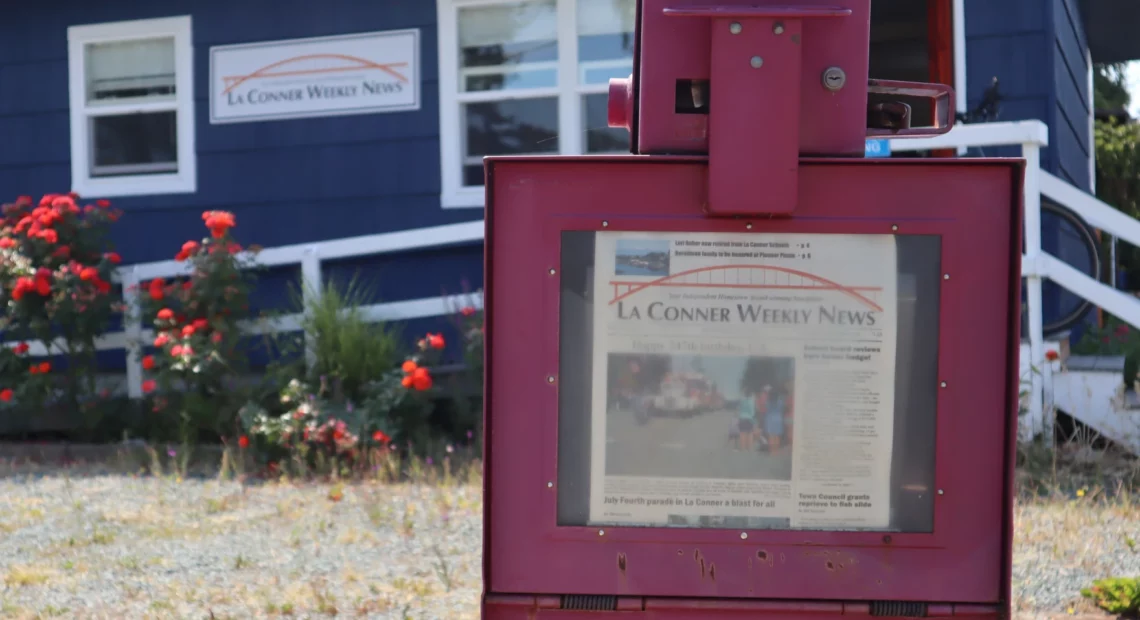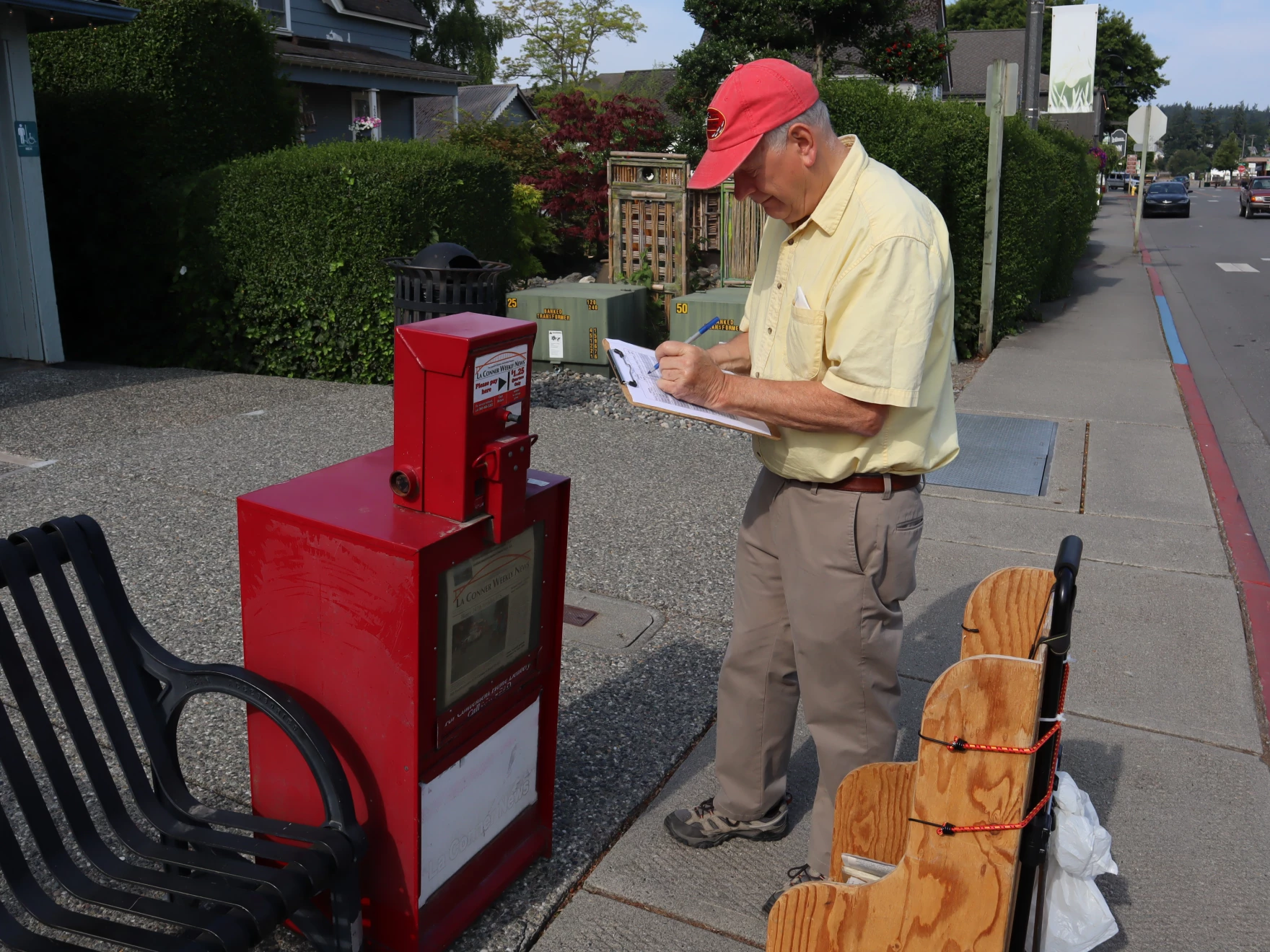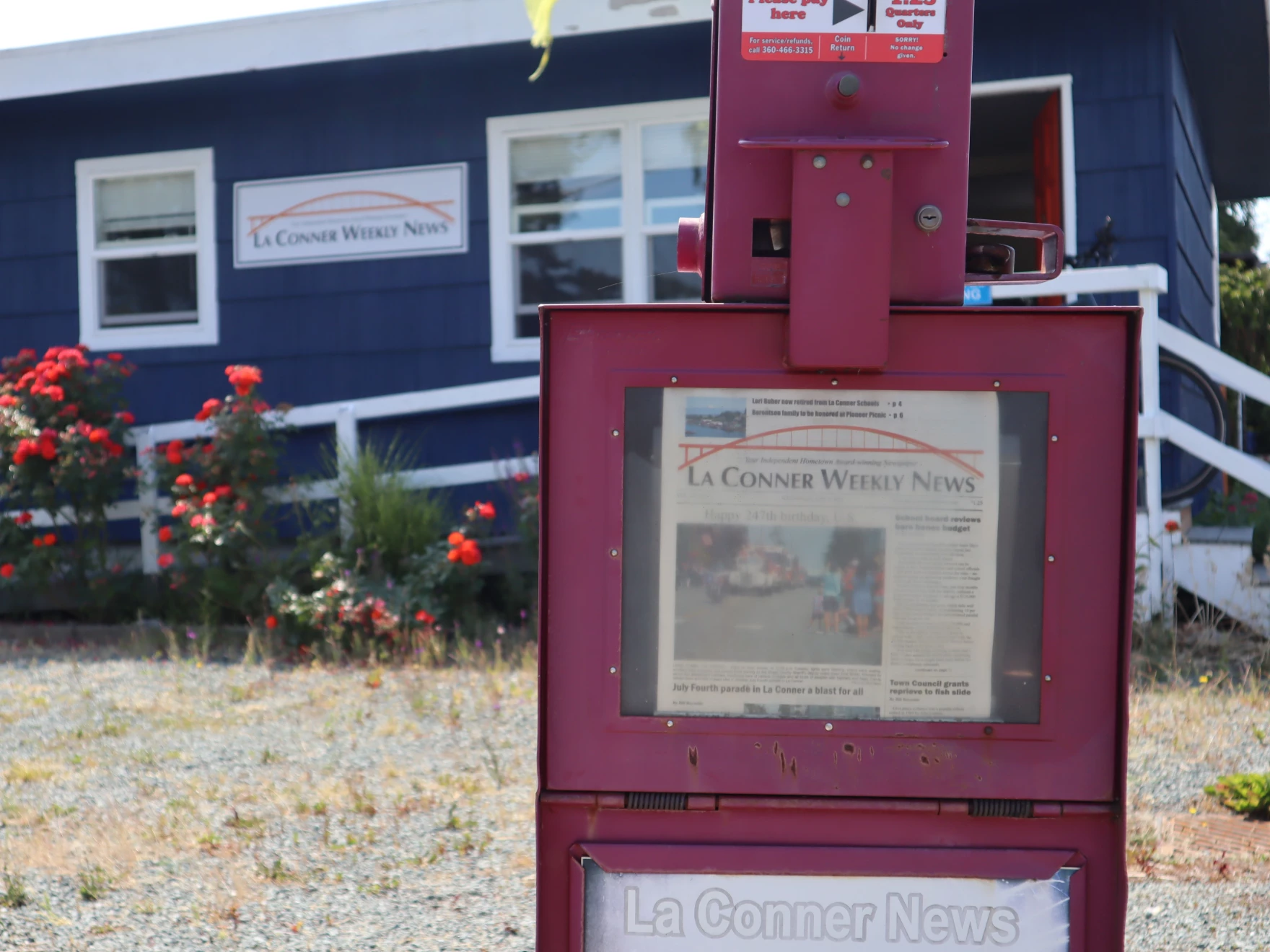
‘It’s really a crisis’: Why small towns are fighting to save their local newspapers
Listen
(Runtime 4:25)
Read
By Jeanie Lindsay
With a stack of fresh newspapers in hand, Ken Stern is making one of his first stops of the day at La Conner’s local office supply and business center.
He greets the owners, Christina and Robyn Burdick-Good-Rubenstein–and their dog, Clover. Stern knows exactly what they want, as the chanting begins: “Crossword day! Crossword day!”
Stern is publisher and editor of the La Conner Weekly News. He doesn’t always deliver papers himself, but today he’s playing tour guide while he restocks local shops and newspaper boxes scattered across the two main streets of town. The small fishing community turned tourist destination is home to less than a thousand people; there isn’t a traffic light anywhere in La Conner.
At 68 years old, Stern is ready to retire. But, first, he has to sell the newspaper to a new publisher. Stern compares it to trying to sell a buggy whip factory.
“It’s very hard in 2023 to sell a buggy whip factory. No matter how high quality my buggy whips are, there’s not much demand,” he said.
The La Conner Weekly is one of a handful of small-town newspapers across the Pacific Northwest on the cusp of a new chapter. In Eastern Oregon, the Malheur Enterprise is looking for new ownership, as its publisher also looks to retire after decades working in journalism. In Southwest Washington, the publisher of one rural county’s only newspaper, the Wahkiakum County Eagle, recently died, leaving the paper’s long term future unclear.
All three publications share similar goals: keep local news local and keep the papers going.
It’s a daunting page to turn in an ever-evolving industry. The numbers paint a bleak picture. Washington lost 20% of its local newspapers since 2004, according to one report from the League of Women Voters of Washington. Just this summer, a legacy newspaper in Central Washington, the Grant County Journal, closed up shop after more than 100 years in business.
“It’s really a crisis for a lot of small towns, and it’s an essential part of democracy to have a newspaper in a town,” said Fred Obee, executive director of the Washington Newspaper Publishers Association.
Obee says less coverage of local government–think school boards, town councils and commissioners–means less community involvement. Some research says a lack of local news can make political polarization worse.
Managing the business of a small paper is no easy feat. Money from advertising isn’t what it used to be, Obee says. National chain stores don’t need to run local ads as much, and social media has siphoned away even more advertising dollars.
“The crushing blow really was COVID,” Obee said.
Back in Northwest Washington, Stern says the La Conner Weekly has bucked that trend a bit, with ad sales increasing in recent years. That’s important, because individual paper sales and subscriptions only make up about 18% of revenue.
“I can sell one paper a month out of some of the boxes, but it’s better to have ’em out there than to take ’em away,” Stern said.

La Conner Weekly News’ editor and publisher Ken Stern uses a clipboard to track how many copies of the weekly paper are sold at the different stops around town, including newspaper boxes, the local grocery store, and several coffee shops nearby. He says he’s noticed a decline in the number of papers sold from the boxes over the years but wants to keep them available. (Credit: Jeanie Lindsay / Northwest News Network)
But the La Conner Weekly’s survival will likely take more community buy-in–literally.
Stern wants someone to buy and run the paper and has been posting for-sale ads in different publications, hoping to catch the eye of a mid-career journalist or two willing to move here. Stern himself moved to La Conner from Ohio in 2017, after he realized his job managing a nonprofit wasn’t going to take him into retirement.
“I basically bought myself my last job by buying the La Conner Weekly News,” he said.
Stern is also talking to people who aren’t journalists. He’s exploring the possibility of whether a group of locals could purchase the paper together. Essentially, Stern says, they could act as a board of directors to shape the paper’s future and hire a new managing editor.
Joan Cross is interested in the idea. Cross has lived in La Conner for 45 years and started a physical therapy business in town. She says those conversations are still in the early stages, but she’s interested in ensuring the weekly’s viability into the future however she can.
“We don’t go to the La Conner Weekly News to find out what’s going on in the world,” Cross said. “But what’s going on in our little corner of the world–it’s important. Nobody covers that except the local newspaper.”
Some papers are already finding success with a more investor-led model. Papers in South Carolina have received thousands of dollars in local donations, while a national nonprofit has agreed to buy a group of daily papers in Maine.
Some people in Wahkiakum County have raised questions about grants or philanthropic investments as they consider ways to rally support for the Eagle. But business manager Ian Brandon has doubts about whether those can realistically provide financial stability in the long term.
“That might get us partway down the road,” Brandon said, noting the Eagle is likely going to have to make changes to its revenue structure. For example, the paper is still free online, he says, but that could change as the Eagle tries to craft a sustainable long-term business plan.
And while there is technically a price tag on these publications–Stern hopes to sell the La Conner Weekly for around $265,000–many people in small towns agree the value of their weekly paper goes far beyond any dollar amount.
Christina Burdick-Good-Rubenstein, the co-owner of the local post office supply store in La Conner, certainly loves the paper for its crossword. But when it comes down to it, she says, the paper provides information she just can’t get anywhere else.
“You can have your ear to the ground and still miss something. But to have it in print is… it’s vital,” she said.
So, after Ken Stern finishes this week’s deliveries, he’s getting right back to figuring out what comes next for the La Conner Weekly.
















